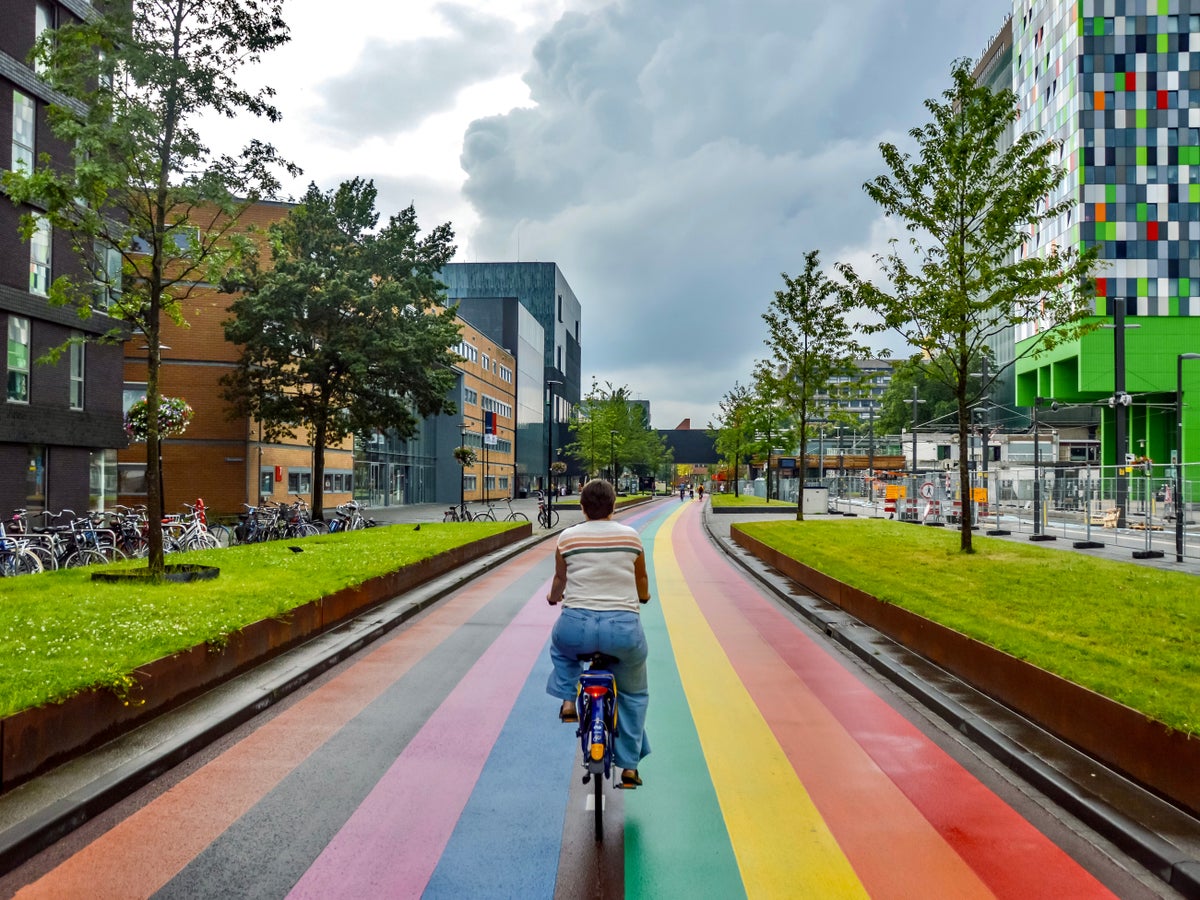
Take a photo in any Netherlandic city and whatever thing of beauty you’re aiming to capture will almost certainly be photobombed by another: the bicycle, in all likelihood the iconic Omafiets (”granny bike”), matriarch of all Dutch models. High-handlebarred, curve-framed, robust yet elegant, somewhere about her cargo there’s a clue to the nature of the journey – a loaf, a football, a satchel, a suit, a cat carrier – each implying a short, practical mission over a leisurely ride. With cycle lanes all over, connecting people to places they need to be, it’s a staggeringly impressive lesson in human geography.
“The greatest trick the car industry ever pulled was convincing the world they needed 1,500kg of machinery to move 15kg of stuff,” Chris Bruntlett, co-author of Building the Cycling City – the Dutch Blueprint for Urban Vitality, tells me. Also marketing and communications manager of the Dutch Cycling Embassy, Bruntlett explains that the organisation came into being a decade ago just to cope with the overwhelming number of enquiries from international governments curious as to how the Dutch model could translate to their own cities. He’s always quick, he says, to reassure them that, despite preconceptions, the Dutch aren’t old masters at cycling infrastructure (50 per cent of the Netherlands’ cycling infrastructure has been built since 1996), so there’s hope that the rest of the world’s planners can move quickly.
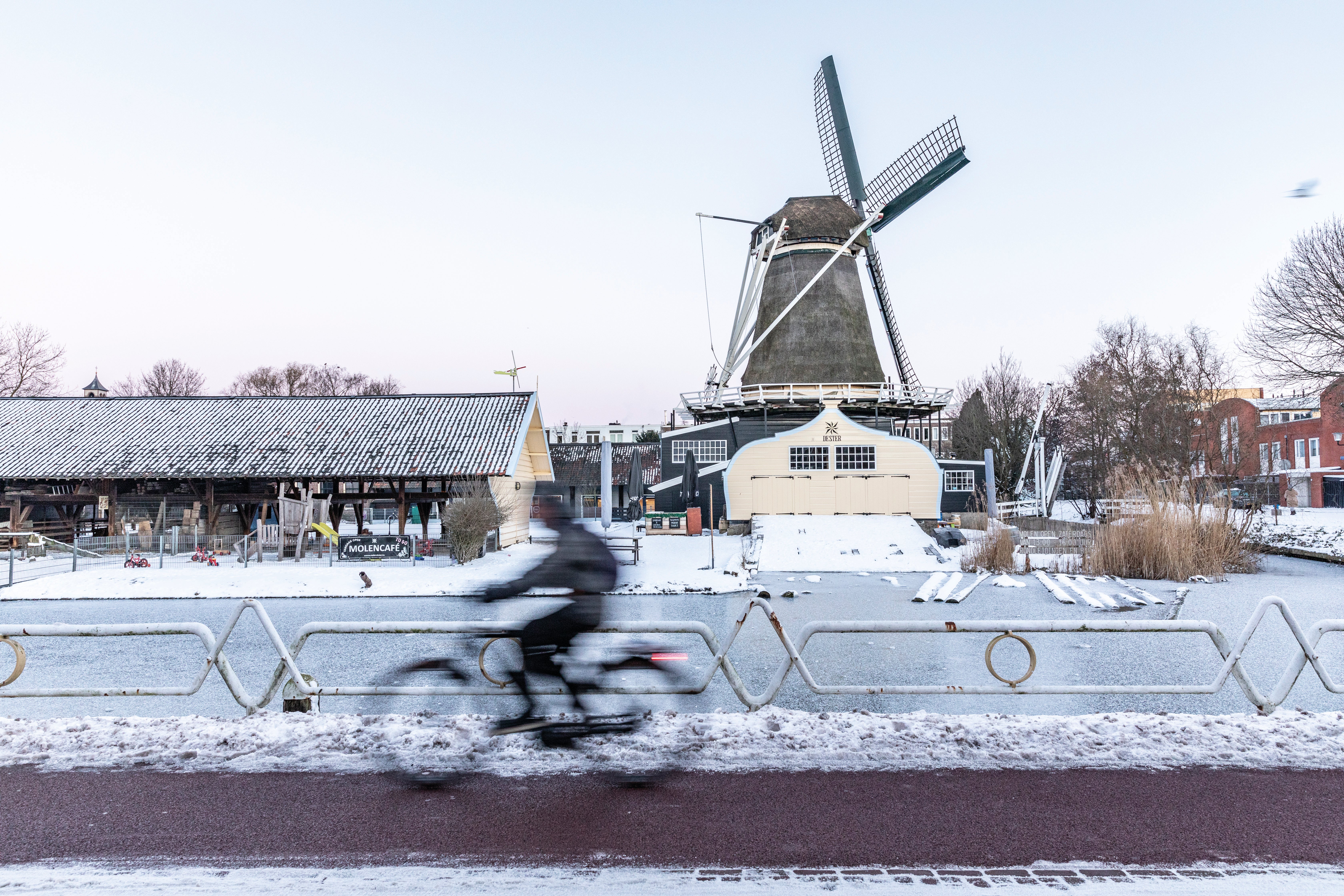
And it’s a sustainability model that it is increasingly urgent to emulate. According to research undertaken by the University of Southern Denmark, 686 million tonnes of carbon would be saved globally if the rest of the world employed the bike as the Dutch do.
Meanwhile, locals using bikes in place of cars is all good news for tourists to the Netherlands, who can expect to find peaceful, clean and safe urban spaces. Drivers are careful around cyclists, too; in the event of a collision, the car driver is fined regardless of whose fault it is. “Urban cycling is designed for safety here,” says Bruntlett. “Bikes are prioritised over cars and there’s a grid of cycle routes, meaning you can essentially cycle from anywhere to everywhere. The infrastructure includes segregated cycle routes on arterial roads; dedicated lanes, traffic lights and crossings; calmed, limited or eliminated motorised vehicles in residential areas and city centres; and so on.”
Saddle up and join the locals
Whether you’re on holiday with an MO of mimicking the natives, or you’re here to take a pragmatic look at how your own city could get its cycling act together, plan a route and hire some pedals. If city cycling looks off-putting to you (the Dutch can appear to have the inimitable skill of bees in a hive), just have a think about where to start and maybe avoid Amsterdam – for your first foray at any rate, given the somewhat hairy confluence of trams, pedestrians, cyclists and unversed strolling tourists in the heart of the city.
The greatest trick the car industry ever pulled was convincing the world they needed 1,500kg of machinery to move 15kg of stuff— Chris Bruntlett
Choose an alternative contender for Venice of the North, such as Utrecht, a neater and equally easy on the eye metropolis, kicking off with a guided tour by bike to get to grips with city cycling. The medieval heart is now car-free and, since Utrecht is home to the Netherlands’ biggest rail hub, you can then head out on day trips with ease, like the spokes of a bicycle wheel. Don’t hoick a bike on the train but hire one instead on alighting. (Bikes are discouraged on trains, with natives incentivised instead to park them at the departure station’s underground bike storage facility or Fietsenstalling, picking up another at the destination from a pool of OV-Fiets, public-transport bikes.)
Where to cycle in Utrecht
Whatever you do, don’t call the city a “mini-Amsterdam” within a Utrechter’s earshot. The archetypal canalscapes might compel you to do so, but the Netherlands’ tallest church tower, an unusually youthful population and the lively double-level canalside streets lend the city its points of difference.
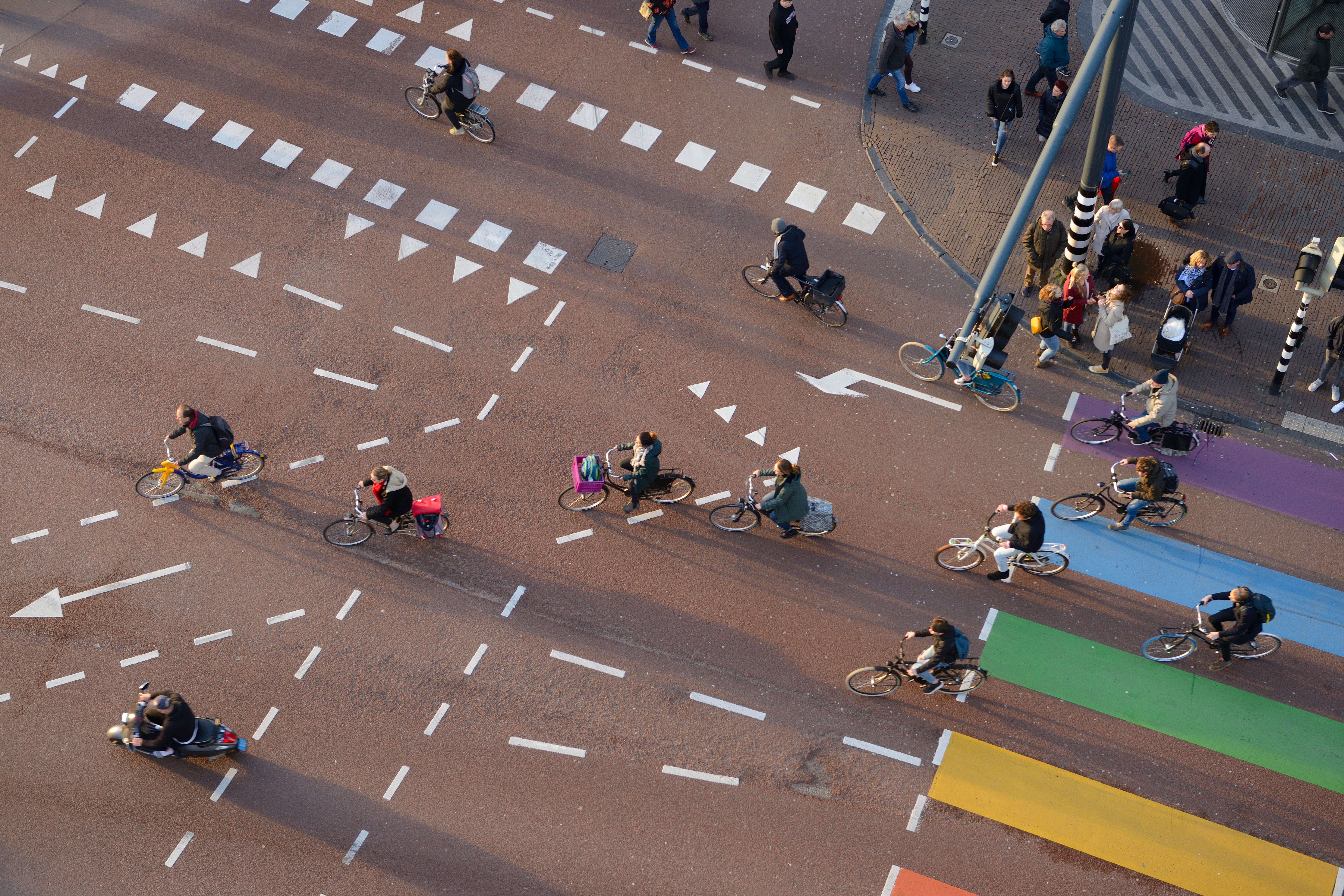
The fictional rabbit Nijntje (Miffy) dominates postcard racks and has her own museum, but you’ll also find around 15 further museums, plus street art, “stumbling stones” (pavement tiles informing passers-by of former residents who became Holocaust victims) and an ecclesiastically dimensioned municipal bibliotheek (library) with one of the best coffee addresses in town.
Cycle through Wilheminapark to the Unesco-listed Rietveld Schröder house, its striking design and palette more Eighties-vibed than its centenary belies. Velophiles after photo opps can seek out Centraal station’s vast Fietsenstalling (the biggest in the world) and the rainbow cycling lane in the university district.
Where to cycle in The Hague
The Hague, or Den Haag, is a mere 38-minute Intercity train ride from Utrecht. Long the seat of government and royalty (you have an outside chance of spying PM Mark Rutte or King Willem-Alexander, on wheels of course), a reputation for fashion and art blasts the misconception that Den Haag is merely a place of all things stately. Lock up the bike outside Mauritshuis Museum to see works by the old masters (Girl with a Pearl Earring, The Goldfinch…), mine the antiques, lifestyle and design stores on Denneweg, then cycle 6km to see Voorlinden Museum’s newer masters: artwork sometimes provoking feelings of immersion (in Swimming Pool; in steel maze Open Ended), sometimes playing with proportion (the mouse-sized elevators; the hyper-realistic beach bathers). Cycle back via the forest for a peep at the king’s residential palace: Huis ten Bosch.
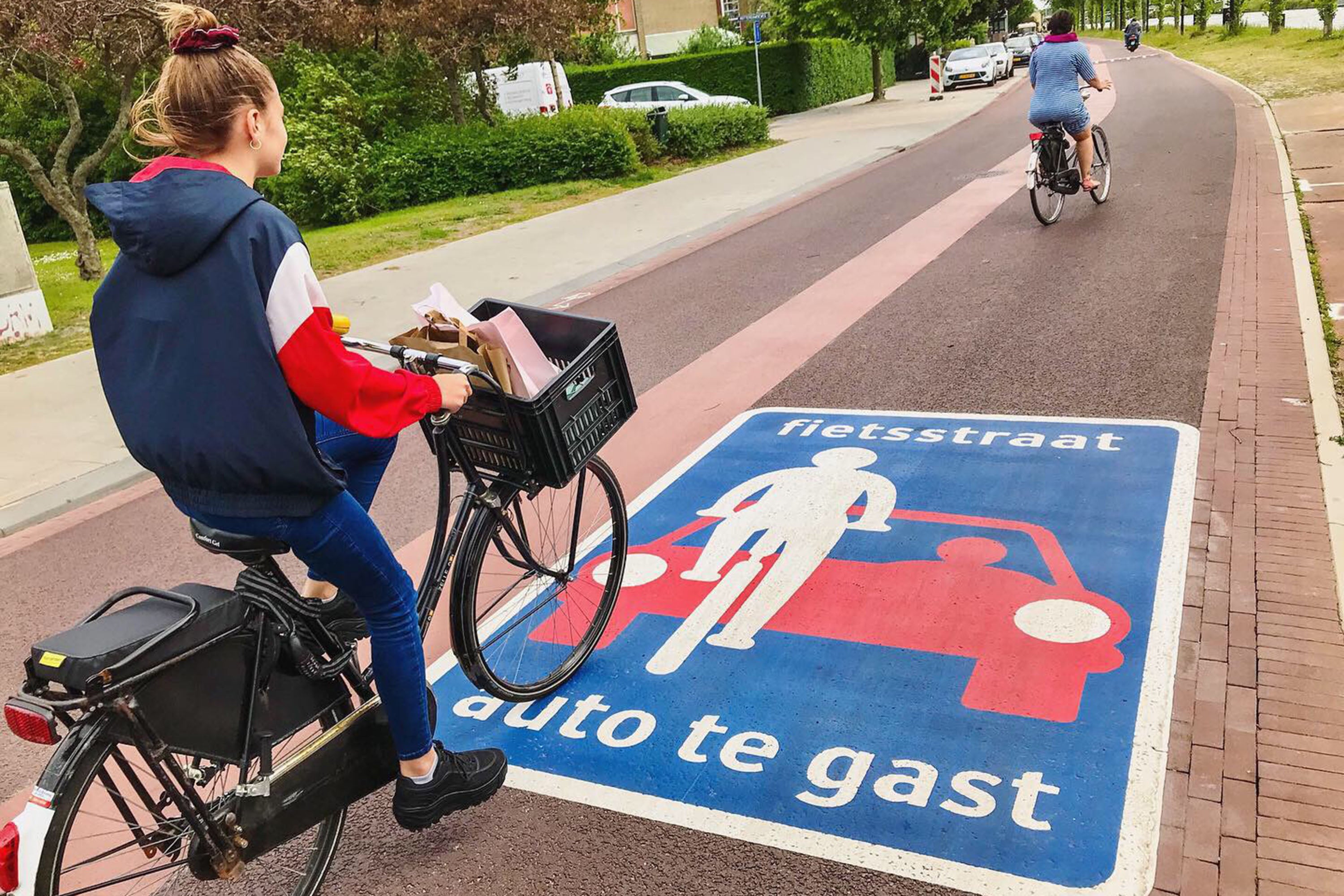
Though cycling is predominantly practical in the Netherlands, it’s also a thing of leisure on Noordeinde, where helmeted road bikers pitch up at Lola Bikes & Coffee for a decent flat white, an ogle at vintage jerseys and for social rides. Over in Delft (approximately 35 minutes by bike from Den Haag), behind-the-scenes guided tours of TU Delft university shine a light on multiple faculties’ research, touching on use of the campus as an urban mobility observatory. Here, virtual reality, a smart cycle path and discreet cameras all assess pedestrian-cyclist interactions and influence policy.
Where to cycle in Amsterdam
Once you’re ready to try your cycling skills in the Dutch capital, it’s a 28-minute Intercity train from Utrecht.
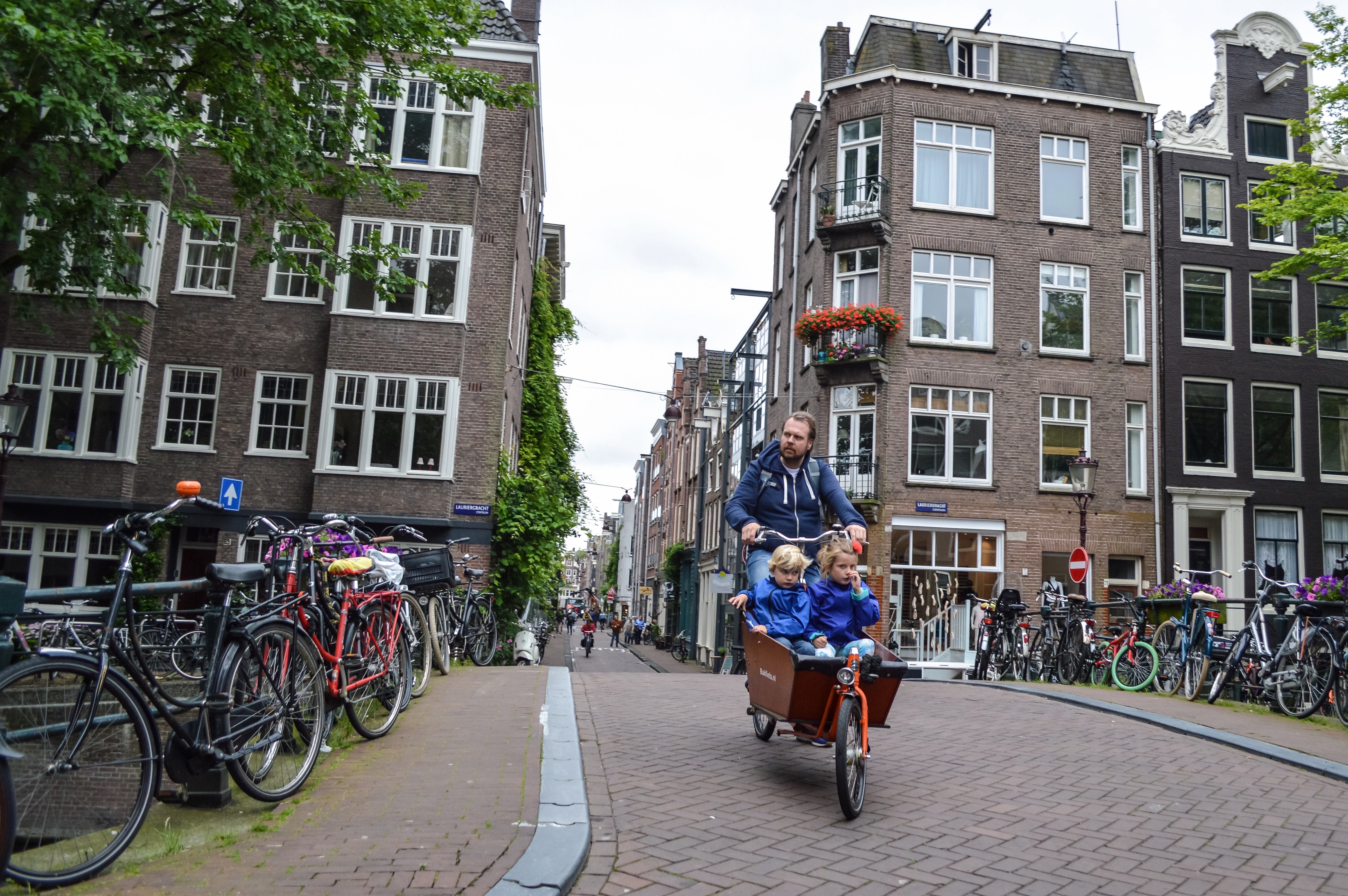
While famous waterways, Anne Frank’s house and the Van Gogh Museum all draw the hordes, second-timers might be more inclined to explore a trail less travelled. From Amsterdam Centraal station, wheel your hired bike onto the toll-free Buiksloterweg ferry to Overhoeks and loop through Noorderpark, where you’ll see a neat manifestation of Dutch multi-transit infrastructure: car lanes, segregated bike lanes and the metro line, all dissecting the park in parallel lines. If you’re curious about what becomes of some of the million bikes discarded annually in the Netherlands, drop into Roetz Bikes in the Hamerkwartier district. Putting the cycle in recycle, they dismantle used bikes, then remanufacture and recirculate them back into the system. Taking the notion of sustainability one step further, they’re also pioneering a “life” bike: with optimum design, customisation, modularity and service, one bike lasts the consumer (literally) their lifetime.
Travel essentials
Getting there
Trying to fly less?
Eurostar operates up to four services a day from London to the Netherlands, from £39 one way (based on a return journey). Your carbon footprint from one flight can be the same as making 13 Eurostar journeys.
Stena Line also runs regular ferry services from Harwich to the Hook of Holland; DFDS sails from Newcastle to Amsterdam; and P&O does a Hull-Rotterdam service.
Fine with flying?
Numerous airlines fly between the UK and the Netherlands, including Ryanair, easyJet, Wizz and British Airways.
Staying there
If you think “hostel” and “boutique” don’t naturally appear in the same sentence, search up Bunk Hotel, where enclosed pods in shared sleep space provide a sense of privacy. (Private rooms also available.) Buzzy dining, an artist-in-residence programme and workspace in this former church all add to the über-cool, plush urban vibe. Bike hire is available here too.
More information
For advice on city cycling, navigation, longer-distance routes and more, visit Holland Cycling Routes and holland.com. Professionals interested in seeing how the Dutch cycling model could be transposed to their own city can enquire about the Dutch Cycling Embassy’s study tours. Members of the public with a sense of cycling culture curiosity can download self-guided tours.







